 Tìm kiếm
Tìm kiếm
Chương I Luật phòng, chống thiên tai 2013: Những quy định chung
| Số hiệu: | 33/2013/QH13 | Loại văn bản: | Luật |
| Nơi ban hành: | Quốc hội | Người ký: | Nguyễn Sinh Hùng |
| Ngày ban hành: | 19/06/2013 | Ngày hiệu lực: | 01/05/2014 |
| Ngày công báo: | 13/07/2013 | Số công báo: | Từ số 407 đến số 408 |
| Lĩnh vực: | Văn hóa - Xã hội | Tình trạng: | Còn hiệu lực |
TÓM TẮT VĂN BẢN
Văn bản tiếng việt
Văn bản tiếng anh
Luật này quy định về hoạt động phòng, chống thiên tai, quyền và nghĩa vụ của cơ quan, tổ chức, hộ gia đình, cá nhân tham gia hoạt động phòng, chống thiên tai, quản lý nhà nước và nguồn lực bảo đảm việc thực hiện phòng, chống thiên tai.
Luật này áp dụng đối với cơ quan, tổ chức, hộ gia đình, cá nhân Việt Nam; tổ chức, cá nhân nước ngoài, tổ chức quốc tế đang sinh sống, hoạt động hoặc tham gia phòng, chống thiên tai tại Việt Nam.
Trong Luật này, các từ ngữ dưới đây được hiểu như sau:
1. Thiên tai là hiện tượng tự nhiên bất thường có thể gây thiệt hại về người, tài sản, môi trường, điều kiện sống và các hoạt động kinh tế - xã hội, bao gồm: bão, áp thấp nhiệt đới, lốc, sét, mưa lớn, lũ, lũ quét, ngập lụt, sạt lở đất do mưa lũ hoặc dòng chảy, sụt lún đất do mưa lũ hoặc dòng chảy, nước dâng, xâm nhập mặn, nắng nóng, hạn hán, rét hại, mưa đá, sương muối, động đất, sóng thần và các loại thiên tai khác.
2. Rủi ro thiên tai là thiệt hại mà thiên tai có thể gây ra về người, tài sản, môi trường, điều kiện sống và hoạt động kinh tế - xã hội.
3. Phòng, chống thiên tai là quá trình mang tính hệ thống, bao gồm hoạt động phòng ngừa, ứng phó và khắc phục hậu quả thiên tai.
4. Đối tượng dễ bị tổn thương là nhóm người có đặc điểm và hoàn cảnh khiến họ có khả năng phải chịu nhiều tác động bất lợi hơn từ thiên tai so với những nhóm người khác trong cộng đồng. Đối tượng dễ bị tổn thương bao gồm trẻ em, người cao tuổi, phụ nữ đang mang thai hoặc đang nuôi con dưới 12 tháng tuổi, người khuyết tật, người bị bệnh hiểm nghèo và người nghèo.
5. Công trình phòng, chống thiên tai là công trình do Nhà nước, tổ chức, cá nhân đầu tư, xây dựng, bao gồm trạm quan trắc khí tượng, thủy văn, hải văn, địa chấn, cảnh báo thiên tai; công trình đê điều, hồ đập, chống úng, chống hạn, chống sạt lở; khu neo đậu tránh trú bão cho tàu thuyền, nhà kết hợp sơ tán dân và công trình khác phục vụ phòng, chống thiên tai.
1. Phòng ngừa chủ động, ứng phó kịp thời, khắc phục khẩn trương và hiệu quả.
2. Phòng, chống thiên tai là trách nhiệm của Nhà nước, tổ chức, cá nhân, trong đó Nhà nước giữ vai trò chủ đạo, tổ chức và cá nhân chủ động, cộng đồng giúp nhau.
3. Phòng, chống thiên tai được thực hiện theo phương châm bốn tại chỗ: chỉ huy tại chỗ; lực lượng tại chỗ; phương tiện, vật tư tại chỗ; hậu cần tại chỗ.
4. Lồng ghép nội dung phòng, chống thiên tai trong quy hoạch, kế hoạch phát triển kinh tế - xã hội của cả nước, địa phương và quy hoạch, kế hoạch phát triển ngành.
5. Phòng, chống thiên tai phải bảo đảm tính nhân đạo, công bằng, minh bạch và bình đẳng giới.
6. Phòng, chống thiên tai phải dựa trên cơ sở khoa học; kết hợp sử dụng kinh nghiệm truyền thống với tiến bộ khoa học và công nghệ; kết hợp giải pháp công trình và phi công trình; bảo vệ môi trường, hệ sinh thái và thích ứng với biến đổi khí hậu.
7. Phòng, chống thiên tai được thực hiện theo sự phân công, phân cấp, phối hợp chặt chẽ giữa các lực lượng và phù hợp với các cấp độ rủi ro thiên tai.
1. Có chính sách đồng bộ về đầu tư, huy động nguồn lực và giải pháp tổ chức thực hiện công tác phòng, chống thiên tai; đầu tư xây dựng công trình phòng, chống thiên tai trọng điểm và hỗ trợ địa phương xây dựng công trình phòng, chống thiên tai theo phân cấp của Chính phủ.
2. Đào tạo, giáo dục, huấn luyện, tuyên truyền nâng cao nhận thức cộng đồng và người dân trong việc tuân thủ pháp luật và tham gia vào công tác phòng, chống thiên tai.
3. Đầu tư cơ sở hạ tầng vùng thường xuyên bị thiên tai; di dời dân sinh sống ở khu vực nguy hiểm đến nơi an toàn; hỗ trợ về đời sống và sản xuất đối với đối tượng bị thiệt hại do thiên tai gây ra, ưu tiên vùng thường xuyên chịu tác động của thiên tai, đối tượng dễ bị tổn thương.
4. Khuyến khích tổ chức, hộ gia đình, cá nhân chủ động thực hiện biện pháp phòng, chống thiên tai; khuyến khích tổ chức, cá nhân đầu tư xây dựng công trình, nghiên cứu và áp dụng tiến bộ khoa học, công nghệ vào hoạt động phòng, chống thiên tai. Nhà nước bảo vệ quyền và lợi ích hợp pháp của tổ chức, cá nhân tham gia phòng, chống thiên tai.
5. Ưu đãi, khuyến khích doanh nghiệp bảo hiểm kinh doanh bảo hiểm rủi ro thiên tai; hỗ trợ đối với doanh nghiệp tham gia đầu tư sản xuất, kinh doanh ở vùng thường xuyên chịu tác động của thiên tai theo quy định của pháp luật về đầu tư, pháp luật về doanh nghiệp và pháp luật về phòng, chống thiên tai; chính sách miễn, giảm thuế thu nhập doanh nghiệp đối với các khoản đóng góp cho phòng, chống thiên tai.
1. Tổ chức, hộ gia đình và cá nhân trên địa bàn là lực lượng tại chỗ thực hiện hoạt động phòng, chống thiên tai.
2. Dân quân tự vệ là lực lượng tại chỗ thực hiện nhiệm vụ phòng, chống thiên tai theo phương án phòng, chống thiên tai của địa phương và sự điều động của người có thẩm quyền.
3. Quân đội nhân dân, Công an nhân dân có trách nhiệm thực hiện nhiệm vụ phòng, chống thiên tai và là lực lượng nòng cốt trong công tác sơ tán người, phương tiện, tài sản, cứu hộ, cứu nạn, bảo đảm an ninh, trật tự an toàn xã hội theo sự điều động của người có thẩm quyền.
4. Tổ chức, cá nhân tình nguyện tham gia hỗ trợ hoạt động phòng, chống thiên tai theo sự chỉ huy của người có thẩm quyền.
1. Vật tư, phương tiện, trang thiết bị cho hoạt động phòng, chống thiên tai bao gồm vật tư, phương tiện, trang thiết bị của Nhà nước; huy động của tổ chức, cá nhân trên địa bàn; của tổ chức, cá nhân, hộ gia đình tự chuẩn bị.
2. Hệ thống thông tin phục vụ quản lý nhà nước và hoạt động phòng, chống thiên tai bao gồm:
a) Cơ sở hạ tầng thông tin gồm hệ thống thông tin công cộng và trang thiết bị chuyên dùng phục vụ cho hoạt động chỉ đạo, chỉ huy phòng, chống thiên tai; thiết bị quan trắc tự động truyền tin; hệ thống thông tin cảnh báo sớm;
b) Cơ sở dữ liệu về thông tin gồm cơ sở dữ liệu về khí tượng, thủy văn, hải văn, động đất, sóng thần; cơ sở dữ liệu về thiên tai và thiệt hại thiên tai; cơ sở dữ liệu về hệ thống công trình phòng, chống thiên tai; cơ sở dữ liệu về công trình hạ tầng có liên quan đến phòng, chống thiên tai; số liệu quan trắc và truyền phát tự động tại thời điểm thiên tai đang diễn ra.
3. Nhu yếu phẩm của tổ chức, cá nhân và hàng hóa, vật tư, thiết bị thuộc dự trữ quốc gia của cơ quan nhà nước phục vụ cho hoạt động phòng, chống thiên tai bao gồm lương thực, thuốc chữa bệnh, nước uống, hóa chất, thiết bị xử lý nước, thuốc khử trùng và vật phẩm cần thiết khác để bảo đảm đời sống nhân dân khi thiên tai xảy ra.
1. Ngân sách nhà nước cho phòng, chống thiên tai bao gồm ngân sách nhà nước theo dự toán chi hằng năm và dự phòng ngân sách nhà nước.
2. Ngân sách nhà nước cho phòng, chống thiên tai theo dự toán chi hằng năm được sử dụng cho xây dựng chiến lược, kế hoạch phòng, chống thiên tai; đầu tư, xây dựng, tu bổ, nâng cấp công trình phòng, chống thiên tai; hoạt động phòng, chống thiên tai; hoạt động thường xuyên của cơ quan quản lý nhà nước về phòng, chống thiên tai các cấp.
Việc lập dự toán, phân bổ, quản lý và sử dụng ngân sách nhà nước cho hoạt động phòng, chống thiên tai được thực hiện theo quy định của pháp luật về ngân sách nhà nước.
3. Dự phòng ngân sách nhà nước cho phòng, chống thiên tai được sử dụng theo quy định sau đây:
a) Hỗ trợ cho công tác ứng phó và khắc phục hậu quả thiên tai;
b) Căn cứ vào hoạt động ứng phó, mức độ thiệt hại, nhu cầu cứu trợ và các chế độ, chính sách, Ủy ban nhân dân tỉnh, thành phố trực thuộc trung ương (sau đây gọi chung là cấp tỉnh), Ủy ban nhân dân huyện, quận, thị xã, thành phố thuộc tỉnh (sau đây gọi chung là cấp huyện), Ủy ban nhân dân xã, phường, thị trấn (sau đây gọi chung là cấp xã) quyết định cấp dự phòng ngân sách của địa phương để xử lý các nhu cầu khẩn cấp cho ứng phó và khắc phục hậu quả thiên tai ngoài dự toán chi hằng năm đã được phê duyệt;
c) Trường hợp dự phòng ngân sách địa phương đã chi hết nhưng không đủ đáp ứng cho các nhu cầu khẩn cấp, Chủ tịch Ủy ban nhân dân cấp tỉnh đề nghị Thủ tướng Chính phủ hỗ trợ. Ban chỉ đạo trung ương về phòng, chống thiên tai tổng hợp tình hình thiệt hại, nhu cầu hỗ trợ của địa phương và đề xuất Thủ tướng Chính phủ quyết định.
1. Quỹ phòng, chống thiên tai là quỹ được thành lập ở cấp tỉnh, do Ủy ban nhân dân cấp tỉnh quản lý. Quỹ phòng, chống thiên tai không bao gồm ngân sách nhà nước và không có nguồn gốc từ ngân sách nhà nước.
2. Nguồn tài chính của Quỹ phòng, chống thiên tai:
a) Đóng góp bắt buộc của tổ chức kinh tế trong nước và nước ngoài tại địa bàn, công dân Việt Nam từ đủ 18 tuổi đến hết tuổi lao động theo quy định của pháp luật;
b) Các nguồn hợp pháp khác.
3. Quỹ phòng, chống thiên tai được sử dụng để hỗ trợ hoạt động phòng, chống thiên tai và ưu tiên hỗ trợ cho các hoạt động sau đây:
a) Cứu trợ khẩn cấp về lương thực, nước uống, thuốc chữa bệnh và các nhu cầu cấp thiết khác cho đối tượng bị thiệt hại do thiên tai;
b) Hỗ trợ tu sửa nhà ở, cơ sở y tế, trường học;
c) Xử lý vệ sinh môi trường vùng thiên tai.
4. Việc quản lý, sử dụng Quỹ phòng, chống thiên tai phải bảo đảm đúng mục đích, kịp thời, công khai, minh bạch, công bằng và hiệu quả.
5. Chính phủ quy định cụ thể việc thành lập, mức đóng góp, đối tượng được miễn, giảm, tạm hoãn đóng góp, quản lý, sử dụng và thanh quyết toán Quỹ phòng, chống thiên tai.
1. Đóng góp tự nguyện của tổ chức, cá nhân cho công tác phòng, chống thiên tai dưới các hình thức: đóng góp vào quỹ xã hội, quỹ từ thiện; tham gia quyên góp theo quy định của pháp luật và hỗ trợ trực tiếp cho tổ chức, hộ gia đình, cá nhân bị thiệt hại do thiên tai.
2. Việc phân bổ, sử dụng nguồn đóng góp tự nguyện quy định tại khoản 1 Điều này được thực hiện theo quy định của pháp luật về quỹ xã hội, quỹ từ thiện và có sự thống nhất của chính quyền địa phương nơi có đối tượng được hỗ trợ.
1. Lợi dụng thiên tai và hoạt động phòng, chống thiên tai gây phương hại đến độc lập, chủ quyền, thống nhất và toàn vẹn lãnh thổ, quốc phòng, an ninh và lợi ích khác của quốc gia; gây mất trật tự xã hội; xâm hại tài sản của Nhà nước và nhân dân, quyền và lợi ích hợp pháp của tổ chức, cá nhân, cộng đồng và thực hiện các hoạt động trái pháp luật khác.
2. Phá hoại, làm hư hại, cản trở sự vận hành của công trình phòng, chống thiên tai.
3. Vận hành hồ chứa thủy lợi, hồ chứa thủy điện, cống, trạm bơm không đúng quy trình được phê duyệt, trừ trường hợp đặc biệt thực hiện theo chỉ đạo của người có thẩm quyền.
4. Thực hiện hoạt động làm tăng rủi ro thiên tai mà không có biện pháp xử lý, khắc phục, đặc biệt là chặt phá rừng phòng hộ, lấn chiếm bãi sông, lòng sông, tạo vật cản, cản trở dòng chảy, khai thác trái phép cát, sỏi, khoáng sản gây sạt lở bờ sông, bờ biển.
5. Chống đối, cản trở, cố ý trì hoãn hoặc không chấp hành sự chỉ đạo, chỉ huy phòng, chống thiên tai của cơ quan hoặc người có thẩm quyền.
6. Chống đối, cản trở hoặc không chấp hành quyết định huy động nhân lực, vật tư, phương tiện, trang thiết bị, nhu yếu phẩm phục vụ ứng phó khẩn cấp thiên tai của cơ quan hoặc người có thẩm quyền.
7. Lợi dụng thiên tai đầu cơ nâng giá hàng hóa, vật tư, phương tiện, trang thiết bị, nhu yếu phẩm để trục lợi, gây thiệt hại tới đời sống dân sinh.
8. Sử dụng sai mục đích, chiếm dụng, làm thất thoát tiền và hàng cứu trợ; cứu trợ không kịp thời, không đúng đối tượng.
9. Cố ý đưa tin sai sự thật về thiên tai và hoạt động phòng, chống thiên tai.
10. Cố ý báo cáo sai sự thật về thiệt hại do thiên tai gây ra.
Article 1. Scope of regulation
This Law provides natural disaster prevention and control activities; rights and obligations of agencies, organizations, households and individuals engaged in natural disaster prevention and control activities; and the state management of, and assurance of resources for, natural disaster prevention and control.
Article 2. Subjects of application
This Law applies to Vietnamese agencies, organizations, households and individuals; foreign organizations and individuals and international organizations that are residing or operating or engaged in natural disaster prevention and control in Vietnam.
Article 3. Interpretation of terms
In this Law, the terms below are construed as follows:
1. Natural disasters means abnormal natural phenomena which may cause damage to human life, property, the environment, living conditions and socio- economic activities. Natural disasters include typhoon, tropical low pressure, whirlwind, lightning, heavy rain, flood, flashflood, inundation, landslide and land subsidence due to floods or water currents, water rise, seawater intrusion, extreme hot weather, drought, damaging cold, hail, hoarfrost, earthquake, tsunami and other types of natural disaster.
2. Natural disaster risk means damage, which natural disasters may cause to human life, property, the environment, living conditions and socio-economic activities.
3. Natural disaster prevention and control means a systematic process involving the prevention of, response to, and remediation of consequences of, natural disasters.
4. Vulnerable group means a group of people who, due to their characteristics and circumstances, are likely to suffer more adverse impacts of natural disasters than other groups in the community. Vulnerable groups include children, elderly people, pregnant women, women nursing under-12-month children, people with disabilities, people suffering from dangerous diseases and poor people.
5. Natural disaster prevention and control works means works, which are built with investment funds of the State, organizations or individuals, including meteorological, hydrographical, oceanographic and seismic observatories, disaster warning stations; dikes, reservoirs and dams, anti- inundation, anti-drought and anti-landslide facilities; storm shelters for ships and boats, evacuation houses and other facilities serving natural disaster prevention and control.
Article 4. Basic principles of natural disaster prevention and control
1. Proactive prevention, timely response to, and urgent and effective remediation of consequences of natural disasters.
2. Natural disaster prevention and control are the responsibility of the State, organizations and individuals in which the State plays the key role, organizations and individuals play a proactive role and communities help one another.
3. Natural disaster prevention and control are carried out under the ‘four on- the-spot motto’: command on the spot, manpower on the spot, means and supplies on the spot and logistics on the spot.
4. Natural disaster prevention and control contents must be integrated into national and local socio-economic development master plans and plans and sectoral development master plans and plans.
5. Humanity, fairness, transparency and gender equity must be guaranteed in natural disaster prevention and control.
6. Natural disaster prevention and control activities must be based on scientific grounds, combining traditional experiences and scientific and technological advances, combining structural and non-structural solutions; protecting the environment and eco-systems and adapting to climate change.
7. Natural disaster prevention and control activities are assigned, decentralized and closely coordinated among involved forces and conform to the levels of natural disaster risks.
Article 5. State policies on disaster prevention and control
1. To adopt synchronous policies on investment and resource mobilization and solutions for organizing natural disaster prevention and control; to build key natural disaster prevention and control works and support localities in building natural disaster prevention and control works as decentralized by the Government.
2. To provide training and education and conduct public information campaigns to raise people’s and communities’ sense of law observance and involvement in natural disaster prevention and control.
3. To invest in infrastructure in areas where natural disasters frequently occur; to relocate people living in dangerous areas to safe areas; to support the livelihoods and production of those suffering from damage caused by natural disasters, giving priority to areas frequently affected by natural disasters and vulnerable groups.
4. To encourage organizations, households and individuals to take proactively disaster prevention and control measures; to encourage organizations and individuals to build natural disaster prevention and control works, and research and apply scientific and technological advances in natural disaster prevention and control activities. The State protects the rights and lawful interests of organizations and individuals engaged in natural disaster prevention and control.
5. To offer incentives to and encourage insurance businesses to provide insurance against natural disaster risks; to support businesses conducting production and business activities in areas frequently affected by natural disasters in accordance with the laws on investment, enterprises and natural disaster prevention and control; to offer enterprise income tax exemption and reduction with regard to contributions made for natural disaster prevention and control purposes.
Article 6. Manpower for natural disaster prevention and control
1. Local organizations, households and individuals are on-the-spot forces, which shall carry out natural disaster prevention and control activities.
2. Militia and self-defense forces are on-the-spot forces, which shall perform natural disaster prevention and control tasks under local natural disaster prevention and control plans and the mobilization of competent persons.
3. The People’s Army and People’s Public Security forces shall perform natural disaster prevention and control tasks and act as the core in the evacuation of people, means and properties, rescue and salvage and assurance of security and social order and safety under the mobilization of competent persons.
4. Organizations and individuals that voluntarily support natural disaster prevention and control activities shall follow the command of competent persons.
Article 7. Supplies, means, equipment, information systems and essentials for natural disaster prevention and control activities
1. Supplies, means and equipment for natural disaster prevention and control activities include supplies, means and equipment of the State; supplies, means and equipment mobilized from local organizations and individuals; and supplies, means and equipment prepared by organizations, individuals and households themselves.
2. Information systems serving the state management and natural disaster prevention and control activities include:
a/ Information infrastructure, including public information systems and specialized equipment serving the direction and command of natural disaster prevention and control activities; automated data-transmission observation equipment; and early warning systems;
b/ Databases, including meteorological, hydrographical, oceanographic, seismic, earthquake and tsunami information database; database on natural disasters and damage caused by natural disasters; database on the system of natural disaster prevention and control works; database on infrastructure facilities related to natural disaster prevention and control; and data automatically observed and transmitted during natural disasters.
3. Essentials of organizations and individuals and national reserves, goods, supplies and equipment of state agencies serving natural disaster prevention and control activities including: food, curative medicines, drinking water, water treatment chemicals and equipment, disinfectants and other necessary articles to assure people’s lives when natural disasters occur.
Article 8. Financial sources for natural disaster prevention and control
1. State budget funds.
2. Natural disaster prevention and control funds.
3. Voluntary contributions of organizations and individuals.
Article 9. State budget funds for natural disaster prevention and control
1. State budget funds for natural disaster prevention and control include funds within annual expenditure estimates and state budget provisions.
2. State budget funds for natural disaster prevention and control within annual expenditure estimates are used for the elaboration of natural disaster prevention and control strategies and plans; construction, renovation and upgrading of natural disaster prevention and control works; natural disaster prevention and control activities; and regular operations of state management agencies at different levels in charge of natural disaster prevention and control.
The estimation, allocation, management and use of state budget funds for natural disaster prevention and control activities comply with the law on the state budget.
3. State budget provisions for natural disaster prevention and control are used according to the following provisions:
a/ To support the response to, and remediation of the consequences of, natural disasters;
b/ Based on response activities, the extent of damage, relief needs, prescribed regimes and policies, the People’s Committees of provinces and municipalities running cities (referred to below as the provincial level), the People’s Committees of districts, towns and provincial cities (referred to below as the district level) and the People’s Committees of communes, wards and townships (referred to below as commune level) shall decide to allocate local budget provisions to meet urgent needs to respond to, and remedy the consequences of natural disasters, which are not covered by the approved annual expenditure estimates;
c/ In case the local budget provisions are used up and insufficient to meet urgent needs, provincial-level People’s Committee chairpersons may propose to the Prime Minister to provide support. The Central Steering Committee for Natural Disaster Prevention and Control shall summarize the damage and support needs of localities and propose the support required to the Prime Minister for his decision.
Article 10. Natural disaster prevention and control funds
1. Natural disaster prevention and control funds are set up at the provincial level and managed by provincial-level People’s Committees. Natural disaster prevention and control funds neither include state budget funds nor originate from the state budget.
2. Financial sources of natural disaster prevention and control funds:
a/ Compulsory contributions of domestic and foreign economic organizations based in localities, and Vietnamese citizens aged from full 18 years and in the working age as prescribed by law;
b/ Other lawful sources.
3. Natural disaster prevention and control funds are used to support natural disaster prevention and control activities, with priority given to the following activities:
a/ Providing emergency relief in food, drinking water, curative medicines and other essentials to those suffering from damage caused by natural disasters.
b/ Supporting the repair of houses, health establishments and schools;
c/ Handling environmental sanitation issues in natural disaster-hit areas.
4. Natural disaster prevention and control funds must be managed and used in a proper, timely, public, transparent, equal and effective manner.
5. The Government shall specify the setting up of natural disaster prevention and control funds, the levels of contributions, subjects eligible for exemption from, reduction or suspension of payment of, contributions, and the management, use, payment and finalization of those funds.
Article 11. Voluntary contributions for natural disaster prevention and control
1. Organizations and individuals may make voluntary contributions for natural disaster prevention and control in the form of contributions to social funds or charity funds; participating in lawful fundraising events, and providing direct support to organizations, households and individuals suffering from damage caused by natural disasters.
2. Voluntary contributions prescribed in Clause 1 of this Article must be allocated and used in accordance with the law on social funds and charity funds and with the agreement of the administrations of localities where supported people reside.
1. Taking advantage of natural disasters and natural disaster prevention and control activities to undermine the independence, sovereignty, unity and territorial integrity, national defense and security and other national interests; cause social disorder; infringe upon the State’s and people’s properties and rights and lawful interests of organizations, individuals and communities, or carry out other illegal activities.
2. Destroying, damaging, or obstructing the operation of, natural disaster prevention and control works.
3. Operating irrigation reservoirs, hydropower reservoirs, sluices and pumping stations in contravention of approved operation processes, except in special cases as directed by competent persons.
4. Carrying out activities, which increase natural disaster risks without taking treatment or remedial measures, especially cutting down protection forests, encroaching river banks and river beds, placing obstacles and obstructing the water currents or illegally exploiting sand, gravel or minerals, causing riverbank or coastline erosion.
5. Opposing, obstructing, intentionally delaying the implementation of, or disobeying competent agencies’ or persons’ direction or command on natural disaster prevention and control.
6. Opposing, obstructing or disobeying competent agencies’ or persons’ decisions on mobilization of manpower, supplies, means, equipment and essentials in urgent response to natural disasters.
7. Taking advantage of natural disasters to speculate and increase the prices of goods, supplies, means, equipment and essentials for self-seeking purposes, causing damage to people’s life.
8. Improperly using, appropriating or losing relief money and goods; failing to provide relief in time or providing relief to ineligible subjects.
9. Intentionally reporting untrue information on natural disasters or natural disaster prevention and control activities.
10. Intentionally making untrue reports on damage caused by natural disasters.
Cập nhật
Bài viết liên quan
Gọi số khẩn cấp để quấy rối phạt đến 3 triệu đồng mới nhất 2025?
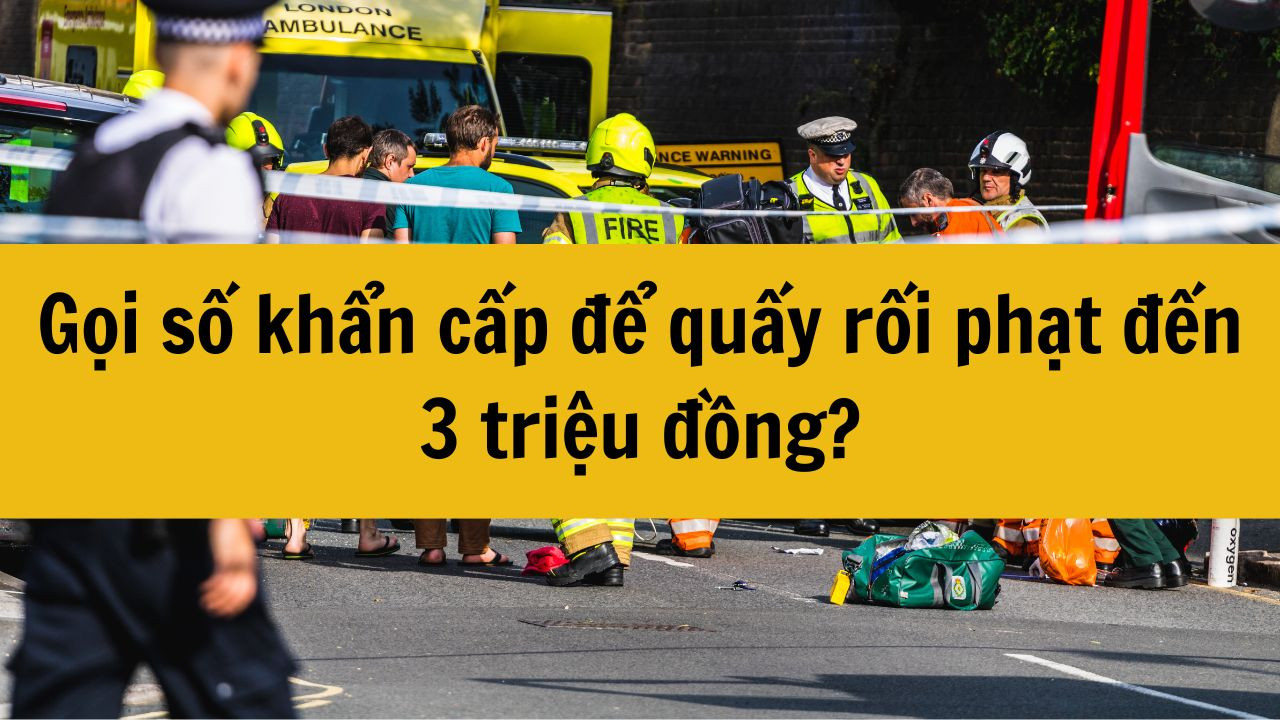
Gọi số khẩn cấp để quấy rối phạt đến 3 triệu đồng mới nhất 2025?
Số điện thoại khẩn cấp ở mỗi quốc gia là khác nhau, nhưng đặc thù đều bao gồm ba chữ số, thông thường chỉ khác nhau ở chữ số cuối để dễ nhớ và bấm nhanh lúc khẩn cấp. Vậy gọi số khẩn cấp để quấy rối phạt đến 3 triệu đồng mới nhất 2025 đúng không? Bài viết sau đây sẽ làm rõ về vấn đề này. 17/03/2025111, 112 là số điện thoại gì? Có phải số khẩn cấp hay không?
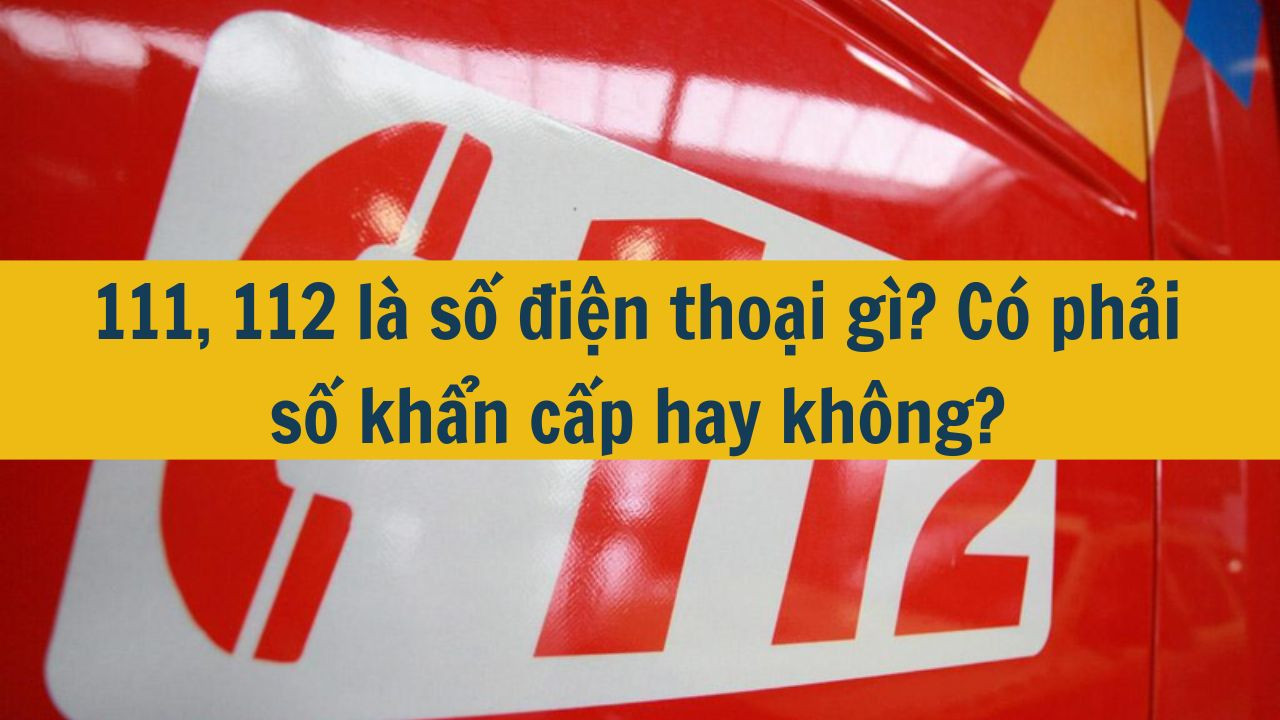
111, 112 là số điện thoại gì? Có phải số khẩn cấp hay không?
Số điện thoại khẩn cấp ở mỗi quốc gia là khác nhau, nhưng đặc thù đều bao gồm ba chữ số, thông thường chỉ khác nhau ở chữ số cuối để dễ nhớ và bấm nhanh lúc khẩn cấp. Vậy 111, 112 là số điện thoại gì? Có phải số khẩn cấp hay không? Bài viết sau đây sẽ làm rõ về vấn đề này. 17/03/2025114 là số điện thoại gì? Hướng dẫn gọi số cứu hỏa 114 báo cháy nhanh chóng mới nhất 2025
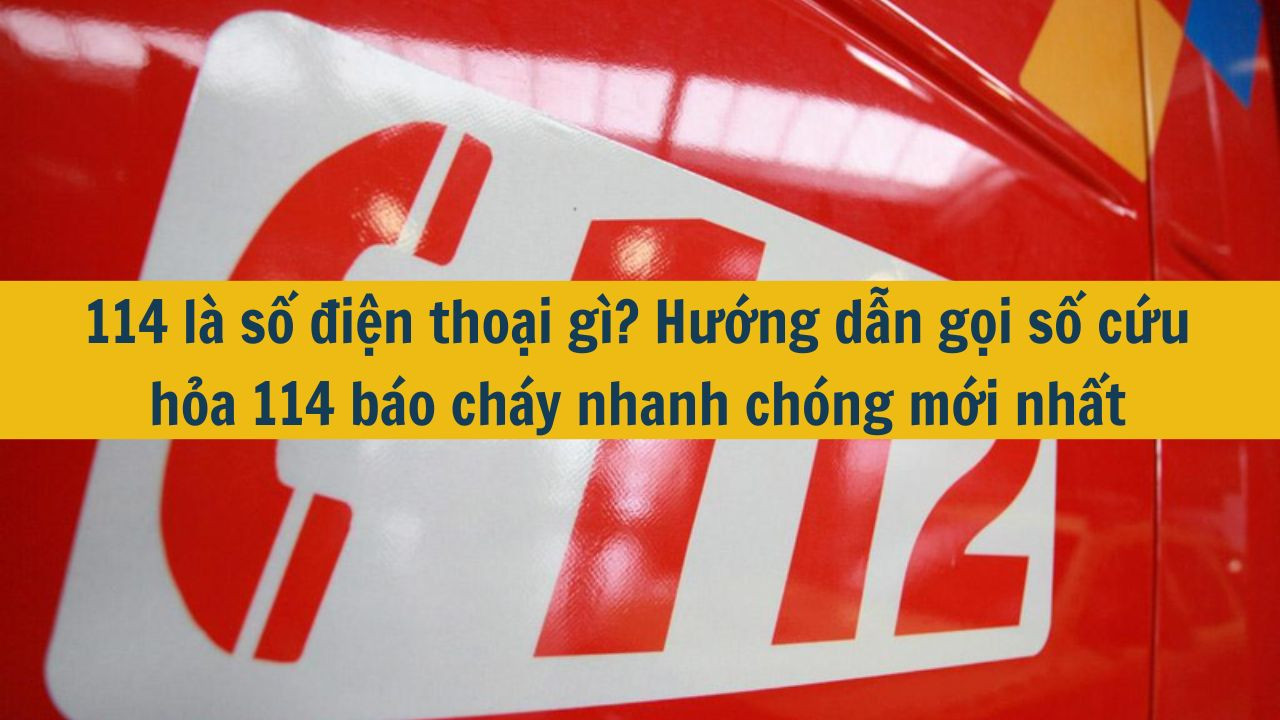
114 là số điện thoại gì? Hướng dẫn gọi số cứu hỏa 114 báo cháy nhanh chóng mới nhất 2025
Số điện thoại khẩn cấp ở mỗi quốc gia là khác nhau, nhưng đặc thù đều bao gồm ba chữ số, thông thường chỉ khác nhau ở chữ số cuối để dễ nhớ và bấm nhanh lúc khẩn cấp. Vậy 114 là số điện thoại gì? Hướng dẫn gọi số cứu hỏa 114 báo cháy nhanh chóng mới nhất 2025. Bài viết sau đây sẽ làm rõ về vấn đề này. 17/03/2025113 là số điện thoại gì? Hướng dẫn gọi số điện thoại cấp cứu 113 nhanh chóng mới nhất 2025
113 là số điện thoại gì? Hướng dẫn gọi số điện thoại cấp cứu 113 nhanh chóng mới nhất 2025
Số điện thoại khẩn cấp ở mỗi quốc gia là khác nhau, nhưng đặc thù đều bao gồm ba chữ số, thông thường chỉ khác nhau ở chữ số cuối để dễ nhớ và bấm nhanh lúc khẩn cấp. Vậy 113 là số điện thoại gì? Hướng dẫn gọi số điện thoại cấp cứu 113 nhanh chóng mới nhất 2025. Bài viết sau đây sẽ làm rõ về vấn đề này. 17/03/2025115 là số điện thoại gì? Hướng dẫn gọi số điện thoại cấp cứu 115 nhanh chóng mới nhất 2025
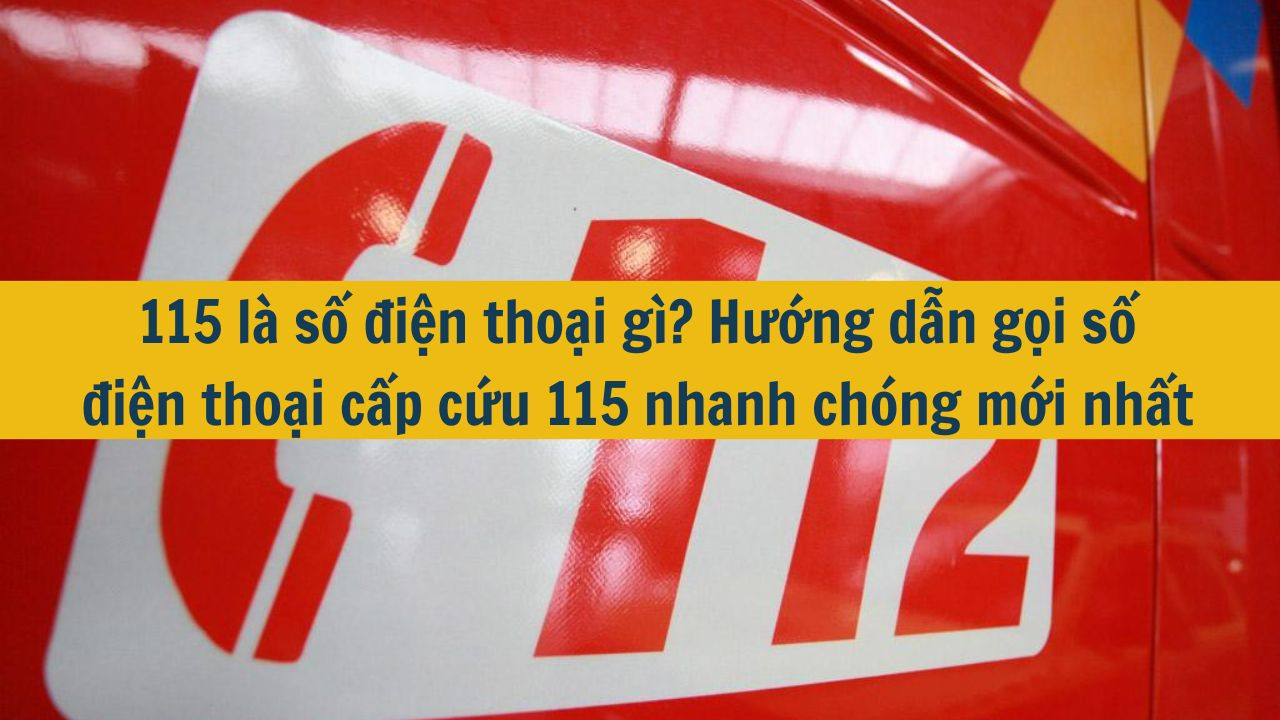
115 là số điện thoại gì? Hướng dẫn gọi số điện thoại cấp cứu 115 nhanh chóng mới nhất 2025
Số điện thoại khẩn cấp ở mỗi quốc gia là khác nhau, nhưng đặc thù đều bao gồm ba chữ số, thông thường chỉ khác nhau ở chữ số cuối để dễ nhớ và bấm nhanh lúc khẩn cấp. Vậy 115 là số điện thoại gì? Hướng dẫn gọi số điện thoại cấp cứu 115 nhanh chóng mới nhất 2025. Bài viết sau đây sẽ làm rõ về vấn đề này. 17/03/2025Gọi số khẩn cấp có cần mã vùng không? Có bị tính cước phí khi gọi số khẩn cấp không?

Gọi số khẩn cấp có cần mã vùng không? Có bị tính cước phí khi gọi số khẩn cấp không?
Số điện thoại khẩn cấp ở mỗi quốc gia là khác nhau, nhưng đặc thù đều bao gồm ba chữ số, thông thường chỉ khác nhau ở chữ số cuối để dễ nhớ và bấm nhanh lúc khẩn cấp. Vậy gọi số khẩn cấp có cần mã vùng không? Có bị tính cước phí khi gọi số khẩn cấp không? Bài viết sau đây sẽ làm rõ về vấn đề này. 17/03/20255 đầu số khẩn cấp ở Việt Nam người dân cần ghi nhớ mới nhất 2025
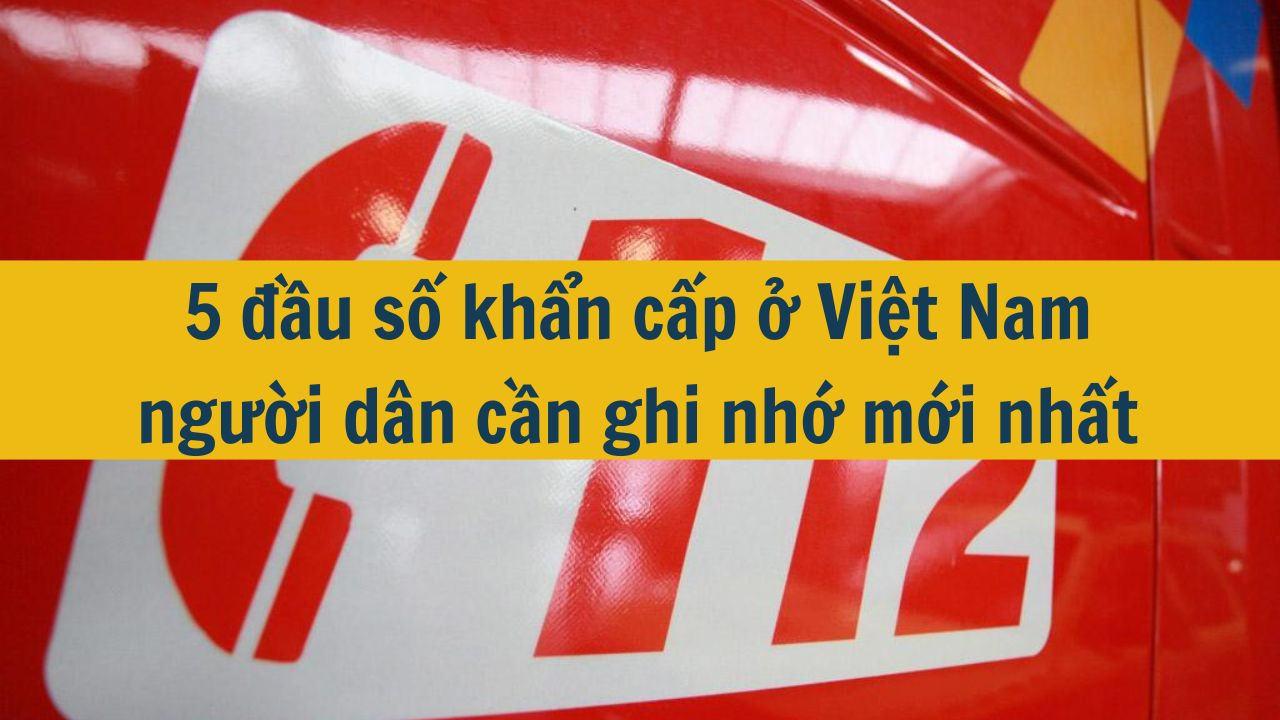

 Luật phòng, chống thiên tai 2013 (Bản Word)
Luật phòng, chống thiên tai 2013 (Bản Word)
 Luật phòng, chống thiên tai 2013 (Bản Pdf)
Luật phòng, chống thiên tai 2013 (Bản Pdf)